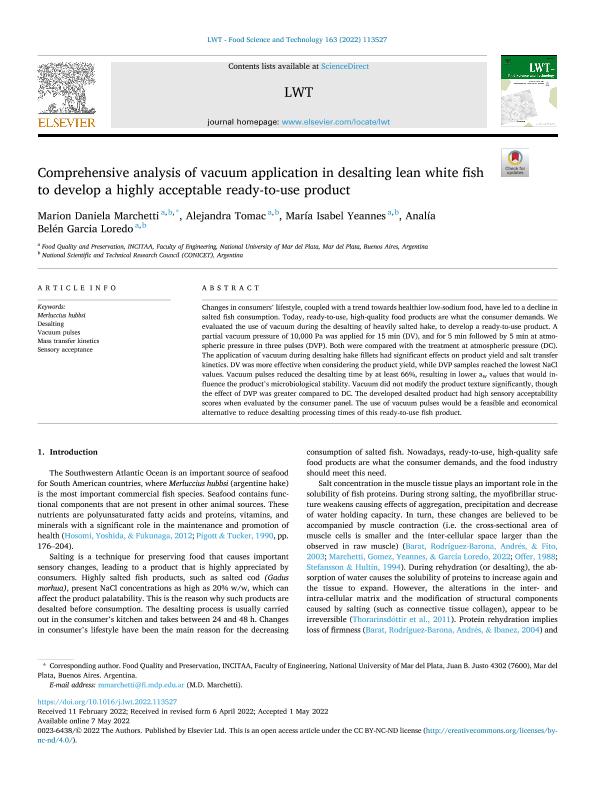Artículo
Comprehensive analysis of vacuum application in desalting lean white fish to develop a highly acceptable ready-to-use product
Fecha de publicación:
06/2022
Editorial:
Elsevier Science
Revista:
LWT - Food Science and Technology
ISSN:
0023-6438
e-ISSN:
1096-1127
Idioma:
Inglés
Tipo de recurso:
Artículo publicado
Clasificación temática:
Resumen
Changes in consumers' lifestyle, coupled with a trend towards healthier low-sodium food, have led to a decline in salted fish consumption. Today, ready-to-use, high-quality food products are what the consumer demands. We evaluated the use of vacuum during the desalting of heavily salted hake, to develop a ready-to-use product. A partial vacuum pressure of 10,000 Pa was applied for 15 min (DV), and for 5 min followed by 5 min at atmospheric pressure in three pulses (DVP). Both were compared with the treatment at atmospheric pressure (DC). The application of vacuum during desalting hake fillets had significant effects on product yield and salt transfer kinetics. DV was more effective when considering the product yield, while DVP samples reached the lowest NaCl values. Vacuum pulses reduced the desalting time by at least 66%, resulting in lower aw values that would influence the product's microbiological stability. Vacuum did not modify the product texture significantly, though the effect of DVP was greater compared to DC. The developed desalted product had high sensory acceptability scores when evaluated by the consumer panel. The use of vacuum pulses would be a feasible and economical alternative to reduce desalting processing times of this ready-to-use fish product.
Archivos asociados
Licencia
Identificadores
Colecciones
Articulos(CCT - MAR DEL PLATA)
Articulos de CTRO.CIENTIFICO TECNOL.CONICET - MAR DEL PLATA
Articulos de CTRO.CIENTIFICO TECNOL.CONICET - MAR DEL PLATA
Citación
Marchetti, Marion Daniela; Tomac, Alejandra; Yeannes, Maria Isabel; Garcia Loredo, Analia Belen; Comprehensive analysis of vacuum application in desalting lean white fish to develop a highly acceptable ready-to-use product; Elsevier Science; LWT - Food Science and Technology; 163; 113527; 6-2022; 1-9
Compartir
Altmétricas




